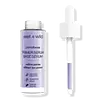What's inside
What's inside
 Key Ingredients
Key Ingredients

 Benefits
Benefits

 Concerns
Concerns

 Ingredients Side-by-side
Ingredients Side-by-side

Water
Skin ConditioningGlycerin
HumectantAlcohol Denat.
AntimicrobialIsopentyldiol
HumectantRosa Damascena Flower Water
MaskingPEG-40 Hydrogenated Castor Oil
EmulsifyingPhenoxyethanol
PreservativePolyacrylate Crosspolymer-6
Emulsion StabilisingCaprylyl Glycol
EmollientEthylhexylglycerin
Skin ConditioningHexylene Glycol
EmulsifyingButylene Glycol
HumectantCamellia Sinensis Leaf Extract
AntimicrobialHydroxypropyl Cyclodextrin
MaskingRibes Nigrum Seed Oil
EmollientOctyldodecanol
EmollientLavandula Hybrida Oil
EmollientLeuconostoc Ferment Filtrate
AntimicrobialCarthamus Tinctorius Seed Oil
MaskingOctyldodecyl Oleate
EmollientPropylene Glycol
HumectantDimethicone
EmollientAroma
Sodium Acrylates Crosspolymer-2
AbsorbentOctyldodecyl Stearoyl Stearate
EmollientCaprylic/Capric Triglyceride
MaskingCichorium Intybus Root Extract
MaskingBakuchiol
AntimicrobialLavandula Angustifolia Flower Extract
CleansingAlcohol
AntimicrobialIodopropynyl Butylcarbamate
PreservativeHydrolyzed Opuntia Ficus-Indica Flower Extract
AbrasiveT-Butyl Alcohol
PerfumingPolysilicone-11
Paeonia Suffruticosa Root Extract
Skin ProtectingSorbitol
HumectantHylocereus Undatus Fruit Extract
Skin ConditioningRosmarinus Officinalis Leaf Extract
AntimicrobialSolidago Virgaurea Extract
Skin ConditioningOligopeptide-68
BleachingDecyl Glucoside
CleansingGlycine Soja Oil
EmollientHydrogenated Lecithin
EmulsifyingTocopheryl Acetate
AntioxidantAscorbic Acid
AntioxidantSodium Oleate
CleansingDisodium EDTA
CI 77891
Cosmetic ColorantCI 16035
Cosmetic ColorantMica
Cosmetic ColorantCI 17200
Cosmetic ColorantCI 42090
Cosmetic ColorantWater, Glycerin, Alcohol Denat., Isopentyldiol, Rosa Damascena Flower Water, PEG-40 Hydrogenated Castor Oil, Phenoxyethanol, Polyacrylate Crosspolymer-6, Caprylyl Glycol, Ethylhexylglycerin, Hexylene Glycol, Butylene Glycol, Camellia Sinensis Leaf Extract, Hydroxypropyl Cyclodextrin, Ribes Nigrum Seed Oil, Octyldodecanol, Lavandula Hybrida Oil, Leuconostoc Ferment Filtrate, Carthamus Tinctorius Seed Oil, Octyldodecyl Oleate, Propylene Glycol, Dimethicone, Aroma, Sodium Acrylates Crosspolymer-2, Octyldodecyl Stearoyl Stearate, Caprylic/Capric Triglyceride, Cichorium Intybus Root Extract, Bakuchiol, Lavandula Angustifolia Flower Extract, Alcohol, Iodopropynyl Butylcarbamate, Hydrolyzed Opuntia Ficus-Indica Flower Extract, T-Butyl Alcohol, Polysilicone-11, Paeonia Suffruticosa Root Extract, Sorbitol, Hylocereus Undatus Fruit Extract, Rosmarinus Officinalis Leaf Extract, Solidago Virgaurea Extract, Oligopeptide-68, Decyl Glucoside, Glycine Soja Oil, Hydrogenated Lecithin, Tocopheryl Acetate, Ascorbic Acid, Sodium Oleate, Disodium EDTA, CI 77891, CI 16035, Mica, CI 17200, CI 42090
Water
Skin ConditioningPropylene Glycol
HumectantInulin
Skin ConditioningAlpha-Glucan Oligosaccharide
CleansingBetaine
HumectantAmmonium Acryloyldimethyltaurate/Vp Copolymer
Sodium Hyaluronate
HumectantMaltodextrin
AbsorbentLactobacillus Ferment
Skin ConditioningGlycerin
HumectantPhenoxyethanol
PreservativeAllantoin
Skin ConditioningPPG-1-PEG-9 Lauryl Glycol Ether
EmulsifyingParfum
MaskingXanthan Gum
EmulsifyingDisodium EDTA
Titanium Dioxide
Cosmetic ColorantIngredients Explained
These ingredients are found in both products.
Ingredients higher up in an ingredient list are typically present in a larger amount.
Disodium EDTA plays a role in making products more stable by aiding other preservatives.
It is a chelating agent, meaning it neutralizes metal ions that may be found in a product.
Disodium EDTA is a salt of edetic acid and is found to be safe in cosmetic ingredients.
Learn more about Disodium EDTAGlycerin is already naturally found in your skin. It helps moisturize and protect your skin.
A study from 2016 found glycerin to be more effective as a humectant than AHAs and hyaluronic acid.
As a humectant, it helps the skin stay hydrated by pulling moisture to your skin. The low molecular weight of glycerin allows it to pull moisture into the deeper layers of your skin.
Hydrated skin improves your skin barrier; Your skin barrier helps protect against irritants and bacteria.
Glycerin has also been found to have antimicrobial and antiviral properties. Due to these properties, glycerin is often used in wound and burn treatments.
In cosmetics, glycerin is usually derived from plants such as soybean or palm. However, it can also be sourced from animals, such as tallow or animal fat.
This ingredient is organic, colorless, odorless, and non-toxic.
Glycerin is the name for this ingredient in American English. British English uses Glycerol/Glycerine.
Learn more about GlycerinPhenoxyethanol is a preservative that has germicide, antimicrobial, and aromatic properties. Studies show that phenoxyethanol can prevent microbial growth. By itself, it has a scent that is similar to that of a rose.
It's often used in formulations along with Caprylyl Glycol to preserve the shelf life of products.
Propylene Glycol is an odorless, colorless liquid. As a humectant, it helps skin retain moisture. It also aids in delivering active ingredients.
Another role of this ingredient is preventing a product from melting or freezing. Propylene glycol also adds antimicrobrial properties to a product, elongating product lifespan.
This ingredient is considered an organic alcohol and commonly added into both cosmetics and foods.
Those with sensitive skin or conditions may develop a rash when using this ingredient.
Learn more about Propylene GlycolWater. It's the most common cosmetic ingredient of all. You'll usually see it at the top of ingredient lists, meaning that it makes up the largest part of the product.
So why is it so popular? Water most often acts as a solvent - this means that it helps dissolve other ingredients into the formulation.
You'll also recognize water as that liquid we all need to stay alive. If you see this, drink a glass of water. Stay hydrated!
Learn more about Water